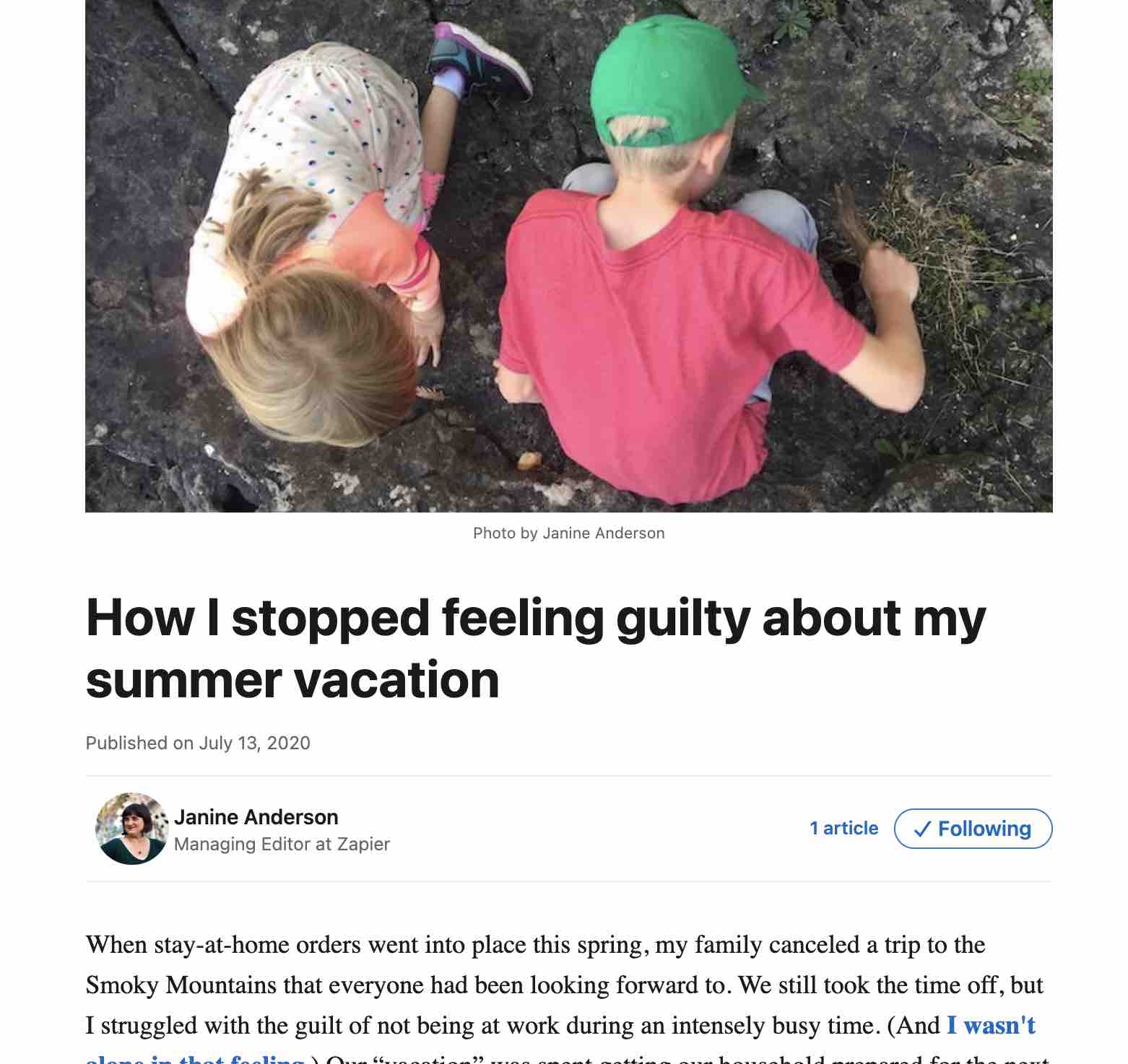Publishing thought leadership content is an effective path to building trust and authority with the people you want to reach. But it's not enough to write compelling content. If you want to execute an effective thought leadership campaign, you need to think critically about where to publish.
There isn't a one-size-fits-all approach, and most likely, you'll want to work with a variety of publication sites and channels to meet different campaign goals. But as a starting point, you can consider the three types of publications:
Let's look at each type of property, including their relative advantages and disadvantages and some examples of making them work for thought leadership.
1. Owned properties
An owned property is any publication asset owned by the thought leadership author or organization. (I know I'm not supposed to use a word in its definition, but come on.) A business's website, blog, newsletter, email list—these are all examples of publication assets that are usually owned by the organization or person publishing the thought leadership.
The Zapier blog, where you are now, is a perfect example of an owned property, and Zapier publishes thought leadership articles on it, like one from co-founder and CEO, Wade Foster, on why the company has always been 100% remote.

Advantages of publishing on owned properties
Complete control. Since you own the publication forum, you have control over all aspects of the forum's operations, from editorial decisions to publication schedules to how/when content is archived. You also don't have to worry about the platform taking down your content or losing your access to the platform.
Easiest to monetize. With full control, you can easily monetize your content: directly, by setting up a paid membership site; or indirectly, by linking to affiliate products and services on your website or in your email newsletter.
Disadvantages of publishing on owned properties
It can't expand its reach on its own. You need to run complementary promotional campaigns to attract a new audience to the owned property in order to expand your reach. But it's likely that you're already investing in campaigns to drive more traffic to your owned properties, so rolling your thought leadership content into those campaigns shouldn't make up a large, additional expense.
Editorial discretion is limited. Your website, blog, email newsletter—whatever it is—has a specific purpose and specific audience. That means any thought leadership you publish on it needs to fit within those parameters, even if they're broad. If you start publishing off-topic content, your readers might run the other way. This usually isn't too much of a problem because most thought leadership you'll publish will fit into that bucket, but it's worth considering.
It's high-maintenance. You own it, you pay for it. There's no landlord to do the heavy lifting needed to keep everything running and in good condition. (Blog randomly starts 404ing? You need to figure it out.) An organization already paying the operational and promotional costs to publish its blog or newsletter won't see a large incremental increase in costs to include thought leadership from internal authors. But if you want to launch a personally-owned property, then the costs and responsibilities are all on you.
Why publish thought leadership on owned assets? Give your known audience more reasons to visit and engage directly with your brand, even when they aren't in a buying phase. You'll build a long-standing relationship with them and continue earning their trust.
2. Long-term leases
A long-term lease property is one where you have your own little corner, but you also have a landlord that can impose terms on your being there. Social media sites are the quintessential example. Organizations and individuals have their own profiles on sites like Twitter and LinkedIn where they have free reign—within the site's terms of service.
But it's not only social media. There are other sites offering long-term leases to publishers for free: think Medium. And there are other platforms, like Patreon, Locals, and Ghost, that help publishers monetize their content (fees for both publishers and readers). These paid thought leadership sites are most valuable for individuals whose content and thought leadership are their product.
Advantages of publishing on a long-term lease site
Excellent for growing your audience. These platforms connect people who might not otherwise find each other. When you publish thought leadership content on an open platform, you're opening a giant door to the world.
Short-form content thrives there. Sites like Twitter and Instagram are made for quick, bite-sized content. Not all thought leadership has to be a 1,500-word article or half-hour podcast.
It's the best opportunity for direct conversations. The open reach and fast, conversational pace of many of these platforms let people have direct conversations with you and your organization.
It encourages the most organic content. Creating valuable thought leadership content requires deliberation and planning—most of the time. Sometimes, you have a lightbulb moment or find yourself in an interesting conversation, and you want to share it immediately. Social media sites and other long-term lease platforms were made to host this type of authentic content. (Yes, I know. This is a double-edged sword. I'll get to that soon.)
Disadvantages of publishing on a long-term lease site
They can be absolute cesspools. Whether it's a social media conversation or the comments section on a long-form site, there's a metric ton of hot takes and nasty remarks out there. Use social media management and listening tools to help wade through the muck to find the valuable, genuine conversations.
You can lose control over or access to your content. From outages to outright bans, the landlords have a lot of control over your little corner of their world. They can remove some of what you publish or erase all your content from their platform. Or the platform might just disappear entirely.
If you're publishing on a long-term lease site, keep your own backups for the content you upload, just in case. For the more organic and conversational content, many of the sites provide download options. LinkedIn, especially, offers terrifically granular download options. Select Settings & Privacy under the Me menu option. Then click How LinkedIn Uses Your Data.

You can also use a third-party service, like pCloud, that offers social media backups. They may not back up all the social media accounts you use, but it can offer a second layer of protection for some of your content.
Why publish thought leadership under a long-term lease? These sites are the digital public squares. No other sites give you broader reach to build two-way relationships with your existing tribe and to bring new people into it. Thought leadership isn't a lecture; it's a discussion—and these platforms let you have them.
3. Vacation rentals
A vacation rental is when you publish on someone else's media property. Unlike a long-term lease, you have no dedicated space on the property. You may have an automated author's page that lists everything you published on the site, but that's it. Most importantly, every visit you want to make requires the prior approval of the landlord. You can't just show up unannounced.
Some examples might be contributing a guest post for a company blog, writing an article for a trade publication, or being a guest on someone else's podcast. Lots of folks are actively seeking external contributors or guest creators, so you have lots of options.
You can reach a broad audience by publishing on a platform with a wider appeal, like this piece from Wade Foster in Inc.

But you might want to consider being a little more targeted by going with industry publications. Here's a directory of trade publications organized by industry, or you can just do a handy Google search. Publications that accept pitches will usually have their submission guidelines posted on their website (if it's not obvious, add "submission" or "pitch" to your search to find them). And Podcast search engine Listen Notes has a classified section of podcasts looking for guests.
If you or your organization work with a PR firm, they can source and negotiate the media placement process. They should also have the media contacts and relationships to get your thought leadership published in the right places to reach the right audience. You can also pitch yourself as a podcast guest on MatchMaker.fm, which matches podcasts and guests.
Advantages of publishing on a vacation rental
It's great for outreach beyond potential customers. Publishing on a vacation rental definitely can get your brand in front of more potential clients, but it's also valuable for reaching other types of audiences. For example, creating media buzz and general interest around your brand can also gain attention from potential investors.
You get a little glow from an established platform. When you publish under the banner of an established media property, they're sharing their earned authority with you. It provides you and your brand with some social proof that you have something interesting to say and expertise worth sharing.
Disadvantages of publishing on a vacation rental
The selection process can be cumbersome. Finding the right publication with the right audience can take time. Then there's the time-consuming process of pitching publications to find the ones that will accept your pitch.
You're constrained by their editorial guidelines. Editorial and submission guidelines can get very detailed, from the exact topics sought to word count requirements. The property's focus is publishing thought leadership topics that serve their audience interests, not the author's.
The platform now owns your content. In most cases, you'll sign something saying that they own your content and can do whatever they want with it. In some ways, that's a good thing: they might repurpose it and get more eyes on it. But it also means you may have less wiggle room in terms of re-using the content yourself—always check first. (This can be true with long-term leases too: read the fine print!)
Why publish thought leadership on a vacation rental? Pairing your brand with an established brand is an opportunity for social validation that pays ongoing dividends. Plus (with their permission), it's co-branded thought leadership content you can repurpose on your long-term lease and owned properties, too.
Build your thought leadership portfolio
Diversify. You don't want to stick with just one type of publication property. Each type—and each publication within that type—serves a different function, and your thought leadership program will work best when you use them in collaboration.










